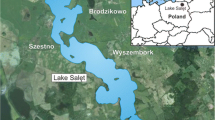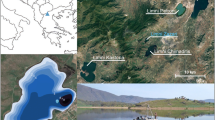Abstract
Past lake-level changes in Lake Kalvsjön are reconstructed and compared with the changes recorded in nearby Lake Bysjön. The two major lowerings of lake level noted in Lake Bysjön are also recorded in Lake Kalvsjön, the older lowering taking place between ca. 9500–9200 B.P. and the younger occurring between ca. 6500–3000 B.P. A distinct decrease in the frequency ofUlmus, corresponding to the classical Elm Decline, is recorded in the pollen diagram from Lake Kalvsjön. The high rapidity of the decline strongly suggests that a pathogenic attack was primarily responsible. However, both human interference and palaeohydrological change may have interacted by disturbing the surrounding forests and increasing the susceptibility of elm to pathogenic attack. In the Lake Kalvsjön area, the disturbance resulting from palaeohydrological change is assumed to have been more influential in pre-disposing the forest to an outbreak of elm disease than any human interference.
Similar content being viewed by others
References
Almendinger JE (1990) Groundwater control of closed-basin lake levels under steady-state conditions. J Hydrol 112: 293–318
Bennett KD (1983) Devensian Late-glacial and Flandrian vegetation history at Hockham Mere, Norfolk, England. New Phytol 95: 457–487
Digerfeldt G (1988) Reconstruction and regional correlation of Holocene lake-level fluctuations in Lake Bysjön, South Sweden. Boreas 17: 165–182
Fægri K (1944) On the introduction of agriculture in western Norway. Geol För Stockh Förh 66: 449–462
Frenzel B (1966) Climatic change in the Atlantic/Sub-boreal transition in the northern hemisphere. Botanical evidence. In: JS Sawyer (ed) World climate from 8000 to 0 B.C. Royal Meteorological Society, London, pp 89–123
Gaillard MJ, Digerfeldt G (1991) Palaeohydrological studies and their contribution to palaeoecological and palaeoclimatic reconstructions. Ecol Bull 41: 275–282
Garbett GG (1981) The elm decline: the depletion of a resource. New Phytol 88: 573–585
Girling MA (1988) The bark beetleScolytus scolytus and the possible role of elm disease in the Early Neolithic. In: M Jones (ed) Archaeology and the flora of the British Isles. Oxford University Committee for Archaeology, Oxford, pp 34–38
Göransson H (1986) Man and the forests of nemoral broad-leaved trees during the Stone Age. Striae 24: 143–152.
Hirons KR, Edwards KJ (1986) Events at and around the first and second Ulmus declines: palaeoecological investigations in Co. Tyrone, Northern Ireland. New Phytol 104: 131–153
Huntley B, Birks HJB (1983) An atlas of past and present pollen maps for Europe: 0–13000 years ago. Cambridge University Press, Cambridge
Iversen J (1960) Problems of the early post-glacial forest development in Denmark. Dan Geol Unders, Række IV, 4(3): 1–32
Iversen J (1973) The development of Denmark's nature since the last glacial. Dan Geol Unders, Række V, 7-C: 1–126
Jörgensen S (1963) Early postglacial in Aamosen. Dan geol Unders, Række II, 87: 1–115
Linnman G (1981) Some aspects of the colonization ofCorylus in north west Europe during Early Flandrian times. Striae 14: 72–75
Molloy K, O'Connell M (1987) The nature of the vegetational changes at about 5000 B.P. with particular reference to the elm decline: fresh evidence from Connemara, western Ireland. New Phytol 106: 203–220
Nilsson T (1948) On the application of the Scanian Post-glacial zonesystem to Danish pollen diagrams. K Dan Vidensk Selsk Biol Skr V(5): 1–53
Nilsson T (1961) Ein neues Standard pollen diagramme aus Bjärsjöholmssjön in Schonen. Lunds Univ Årsskr NF 2(56): 1–34
Nilsson T (1964) Standardpollendiagramme und C14-Datierungen aus dem Ageröds Mosse im mittleren Schonen. Lunds Univ Årsskr NF 2(59): 1–52
O'Connell M (1980) The developmental history of Scragh Bog, Co. Westmeath and the vegetational history of its hinterland. New Phytol 85: 301–319
Olsson IU (1986) Radiometric dating. In: Berglund BE (ed) Handbook of Holocene Palaeoecology and Palaeohydrology. Wiley, Chichester, pp 273–312
Peglar SM (1993) The mid-Holocene Ulmus decline at Diss Mere, Norfolk, UK: a year-by-year pollen stratigraphy from annual laminations. Holocene 3: 1–13
Peglar SM, Birks HJB (1993) The mid-Holocene Ulmus fall at Diss Mere, south-east England - disease and human impact? Veget Hist Archaeobot 2: 61–68
Pennington W (1979) The origin of pollen in lake sediments: an enclosed lake compared with one receiving inflow streams. New Phytol 83: 189–213
Pilcher JR, Smith AG, Pearson GW, Crowder A (1971) Land clearance in the Irish Neolithic: new evidence and interpretation. Science 172: 560–562
Rackham O (1980) Ancient woodland: its history, vegetation and uses in England. Edward Arnold, London
Ralska-Jasiewiczowa M, van Gael B (1992) Early human disturbance of the natural environment recorded in annually laminated sediments of Lake Gosciaz, central Poland. Veget Hist Archaeobot 1: 33–42
Smith AG (1961) The Atlantic - Sub-boreal transition. Proc Linn Soc London 172: 38–49
Sturludottir SA, Turner J (1985) The elm decline at Pawlaw Mire: an anthropogenic interpretation. New Phytol 99: 323–329
Ten Hove HA (1968) TheUlmus fall at the transition Atlanticum-Subboreal in pollen diagrams. Palaeogeogr Palaeoclimatol Palaeoecol 5: 359–369
Troels-Smith J (1960) Ivy, mistletoe and elm: climatic indicators - fodder plants. Dan Geol Unders, Række IV, 4(4): 1–32
Watts WA (1961) Post-Atlantic forests in Ireland. Proc Linn Soc London 172: 33–38
Author information
Authors and Affiliations
Rights and permissions
About this article
Cite this article
Digerfeldt, G. Reconstruction of Holocene lake-level changes in Lake Kalvsjön, southern Sweden, with a contribution to the local palaeohydrology at the Elm Decline. Veget Hist Archaebot 6, 9–14 (1997). https://doi.org/10.1007/BF01145881
Received:
Accepted:
Issue Date:
DOI: https://doi.org/10.1007/BF01145881




